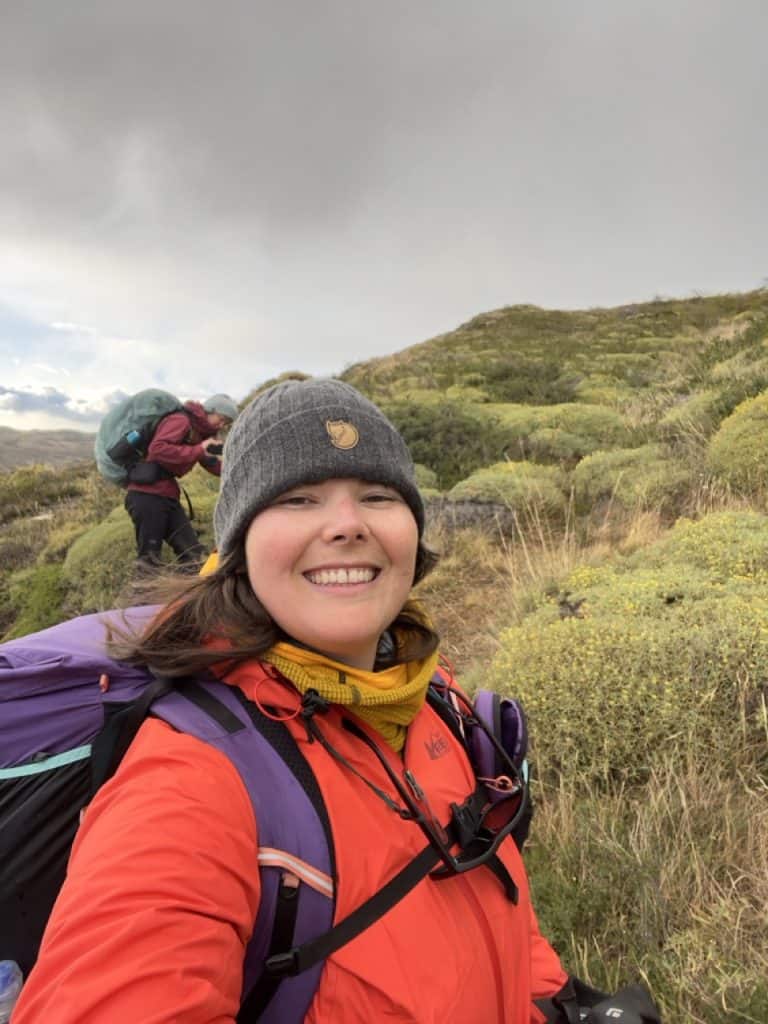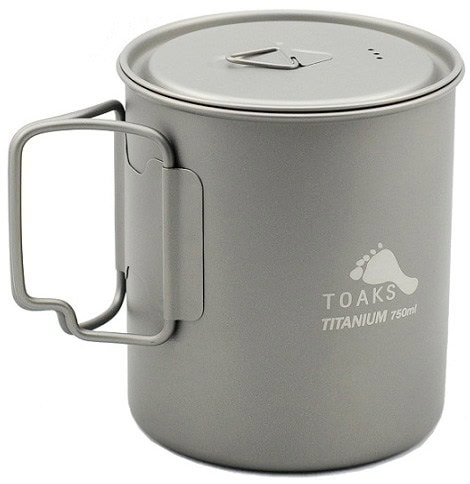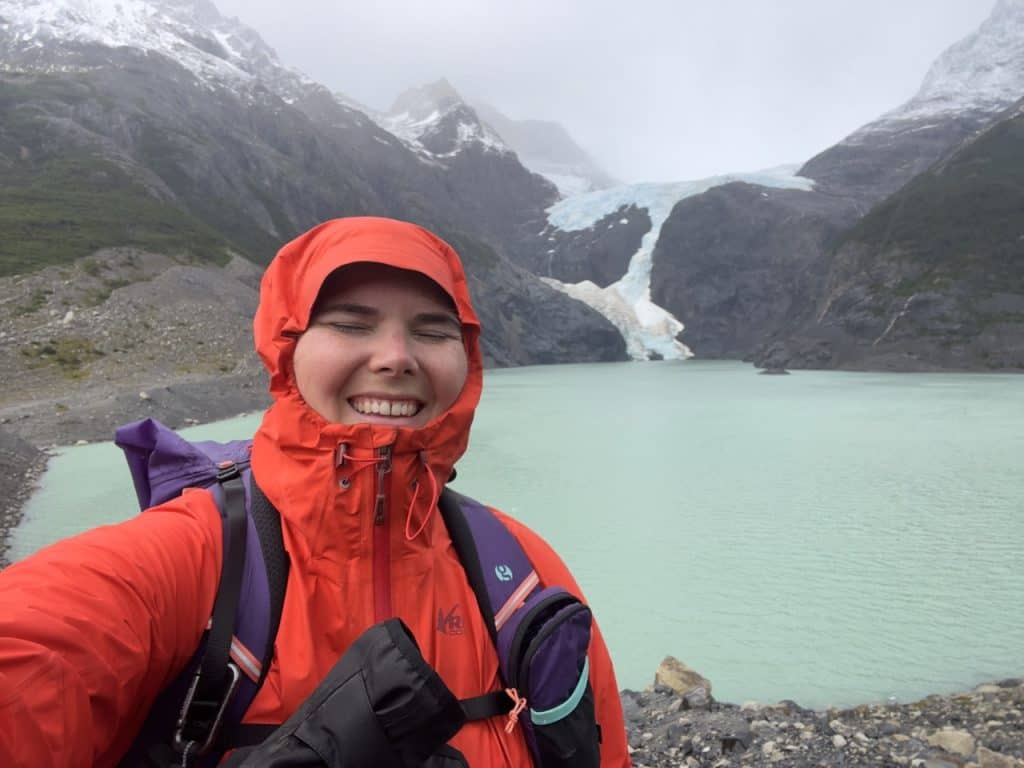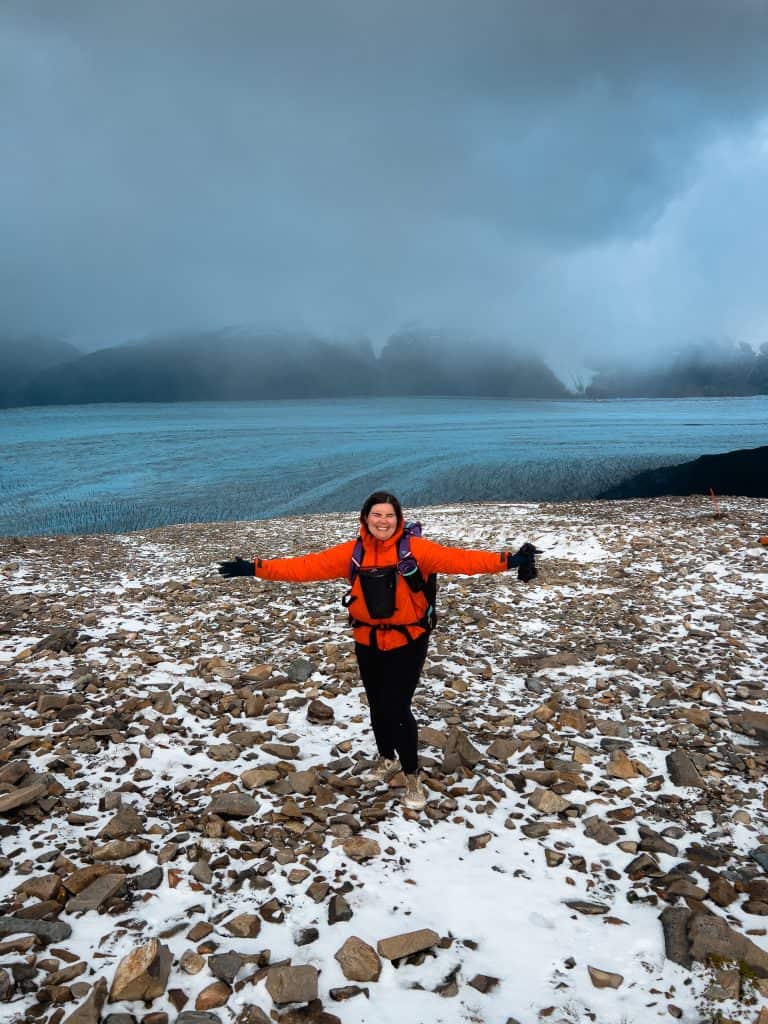O Circuit Packing List: Gear for a Self-Supported Trek
Backcountry Emily contains affiliate links, and I may earn a commission—at no extra cost to you. Some gear in this post may have been gifted or part of a paid collaboration, but I never accept products or partnerships I wouldn’t personally recommend. All opinions are 100% my own. As an Amazon Associate, I earn from qualifying purchases. See my Privacy Policy for more information.
Backpacking in Torres del Paine is a once-in-a-lifetime experience. It’s absolutely stunning, and you’ll feel lucky with every step, but let’s be real: the weather is no joke. Even in the middle of summer, you’ll get everything from sideways rain to blazing sun to snow flurries – sometimes all in one day!
I hiked the full O Circuit self-supported in January 2023 and experienced all four seasons on trail. Gale-force winds at Camp Dickson, downpours near Los Perros, and snow flurries climbing up John Gardner Pass. And a couple days later, I was walking in what felt like the tropics along Lago Nordjenskold.
You need gear that can handle it all – without weighing you down.
After backpacking over 4,000 miles (including a thru-hike of the Pacific Crest Trail), I’ve dialed in what lightweight, functional gear actually works, and this setup carried me through Patagonia without a hitch.
This guide shares exactly what I brought and wore for the O Circuit as a self-supported lightweight backpacker. And comes with a few things I’d do differently next time. And even if you’re staying in Refugios or renting some gear, you’ll find detailed, trail-tested recommendations to help you pack for Patagonia’s predictably unpredictable extremes, and feel confident doing it.

O Trek Gear List: Quick Look
Pack & Gear Storage
Camping Gear – Sleep System
Clothing & Footwear
Clothing Accessories
Cooking & Water Gear
Electronics
Miscellaneous
Backpacking Pack & Gear Storage
Backpack: Gossamer Gear Mariposa 60
The Mariposa 60 L pack is Gossamer Gear’s workhorse pack. I usually carry the smaller Gorilla pack, and I could have on this trip, but having more space was helpful for my travels before & after the O Circuit.
The Mariposa 60 is such a great beginner ultralight pack. It’s not the lightest on the market, but with load lifters and a higher load limit, it’s awesome if you’re transitioning from heavy to UL gear.
One of my favorite features on it is the extra top side pocket: it’s perfect for carrying your cookset or water filtering system.

Pack Accessories
- Gossamer Gear Shoulder Strap Pocket: One of my favorite accessories. The medium fits an iPhone 17 Pro perfectly. Not waterproof, but weather resistant enough.
- Clear Waterproof Pack Liner: I put this in my pack and stuff my important, must-stay-dry items into it. Much lighter than multiple waterproof stuff sacks!
- HMG Weatherproof Camera Pod – Large: Fits my full frame mirrorless camera and mid-size lens with hood on – and it’s waterproof! Perfect for easy access in rough weather.
This is the pack set-up I bring on nearly every single backpacking trip, so I was familiar with it and it worked super well on the O Circuit! I did not bring a separate day pack for hiking to Mirador Britanico or Base Torres. It’s just extra weight and I think it’s easy to carry a mostly empty UL backpacking bag as a day pack.
Camping Gear – Sleep System
Backpacking Tent: Gossamer Gear The One
Some people may think it’s crazy to bring a UL non-freestanding tent to Torres del Paine but I had no issues, even with high winds. The One held up well to the Patagonian winds with proper site selection, and staking and tensioning lines well.
I also pitched it easily on tent platforms at Frances and Chileno using these fishbone stakes. I was super impressed with how easy they were to use!
Non-freestanding tents need special tent poles or trekking poles to be pitched, and I used my strong but light Black Diamond Carbon poles on this trip.
I did not bring a groundsheet on this trip because I didn’t want to deal with one in the wind. This ended up being fine. My tent was a little more dirty than usual on the bottom, but the ground area for tents was always dirt, grass, soft and rock-free, so I had no abrasion issues and the tent floor is waterproof.
My one issue was due to amount of mesh on this tent a lot of dirt got into my tent on super windy nights. But it’s a small price to pay for the weight savings!



Sleeping Quilt: Katabatic Gear Alsek 22
Temperatures can be really chilly on the O Circuit, especially if you hike in the shoulder season, so I recommend having a sleep system rated warmer than 30°F.
Katabatic’s quilts are notoriously rated on the conservative end and I’ve camped in the 20s with this quilt and been warm. If you’re a cold sleeper, you might want to bring a bag or quilt rated to 15°F.

Sleeping Pad: Therm-a-rest NeoAir Xlite NXT
This has been my tried-and-true sleeping pad for all my years of backpacking. It’s the lightest for how warm it is and it’s comfortable even after a week of backpacking the O Circuit!

Pillow: Sea to Summit Aeros UL
Pillows can be finicky when backpacking, but this one, in the smaller size, has been my go-to. It’s way more comfortable than a stuff sack of smelly clothes or lumpy food – and only 2 oz! I like to slightly deflate mine for more comfort.

Clothing & Footwear For Torres del Paine
Hiking Clothes
- Hiking shirt: Outdoor Research Echo Hoodie
- Hiking pants: Athleta Highlands Cargo Pant
- Bra: Patagonia Barely (discontinued) → alternative: Vuori AllTheFeels Bra
- Underwear: Icebreaker Siren Bikini
- Socks: Injinji Midweight Crew x2
- Trail runners: Altra Lone Peak

This whole outfit worked just fine for my needs. Everything breathed well and dried fast and no chafing or blisters. I always recommend bringing 2 pairs of hiking socks for backpacking trips in case 1 pair gets super wet & alternating the pairs every day.
→ What I’d Do Differently: This hiking top is pretty thin and is only rated to UPF 15. I prefer to use this more durable but still breathable top now (and it’s less expensive!). I was also bummed that the pants I wore really stretched out after a couple days of wearing them. I had to constantly pull them up, which is just a drag. I wore these Kuhl pants on the second half of my trip in Argentina and like them so much more. Better fit, great pockets, and don’t fall down.
→ Note on Trail Running Shoes: I use Altra trail running shoes for all of my hiking and backpacking. It’s what my feet love the most, what I’m used to, and my legs and ankles are adapted to this. You might need more support on your feet if you’re not used to backpacking in minimalist shoes. Danner boots are some of my favorite for wide-footed ladies like myself.
Warm & Waterproof Layers – Crucial For Patagonia Weather
- Insulated Jacket: Mountain Hardwear Ghost Whisperer Hoodie
- Fleece: Melanzana → alternative: Mountain Hardwear Summit Grid Tunic Hoodie
- Rain Jacket: REI Co-op Drypoint GTX (discontinued) → alternative: REI Co-op XeroCloud 3L
- Rain Bottoms: Enlightened Equipment Rain Wrap

These layers are absolutely non-negotiable for a safe and comfortable O Circuit hike. I was very happy with my rainy and warm layers on this trip.
I normally don’t bring a fleece layer in addition to a puffy jacket and you might not need it on your hike, but I was pretty cold while hiking to Base Torres at sunrise and up John Gardner Pass while it was snowing and happy to have an active warmth fleece layer.
My rain wrap is so handy to keep my thighs and butt from getting wet while raining – it weighs less than 2 oz too and easier to deal with vs. rain pants!
→ What I’d Do Differently: Because the grid fleece is pretty heavy (heavier than my puffy jacket), I’d still bring an active warmth layer, but trade it for a Polartec Alpha Direct fleece which is over 50% lighter, more breathable, and still provides warmth while moving. I also have not had the chance to test out the new, non-GORE-TEX version of the REI rain jacket so can’t say how it performs. But I know my Arc’teryx rain jacket is bomber and I would recommend it for Patagonia’s weather extremes.
Sleeping Clothes
- Sleeping Top: Patagonia Capilene Lightweight
- Sleeping Bottoms: Patagonia Capilene Lightweight (discontinued) → alternative: REI Co-op Lightweight Tights
- Sleep Socks: Darn Tough Hiker Micro Crew
This is my sleeping set-up for all of my summer backpacking trips, even in cooler conditions. It worked very well on the O Circuit because my sleeping quit & pad is so warm.
I personally like to bring a separate pair of “sacred” sleeping socks: I never wear these socks to hike in, they’re only for sleeping in and they always stay dry & not sweaty. It’s a safety item in case I get extremely cold.
Clothing Extras
- Beanie: Fjallraven
- Neck Gaiter: Buff
- Liner Gloves: Montbell Chameece (Japan only) → alternative: SKIDA Liner Gloves
- Waterproof Mittens: REI Co-op Minimalist GTX
- Camp Slides: Birkenstock Madrid EVA
- Sunglasses: Knockaround
These small accessories really make a trip, in my opinion. They might seem unnecessary, but when it’s pouring down rain and 40°F, trust me, you want the liner gloves and waterproof mitten combo so your hands don’t loose feeling.
I also think camp shoes are essential for the O Circuit because you’ll probably want to change out of your damp hiking shoes when you go inside the cooking building or restaurants in the Refugios. Your feet can breathe more and you’ll give your boots a better chance to dry out.
Something I left behind on this hike was a hat. I didn’t want to deal with the Patagonia winds blowing it off my head. And I didn’t miss it at all! Just wore my sunglasses and made sure I reapplied sunscreen.

Cooking Gear, Water & Food You Need On the O Circuit
Stove: MSR PocketRocket Deluxe
This is my go-to cooking stove. It’s so much lighter compared to bulky Jetboils and boils water super fast. And it’s only 3 oz.!

Pot: Toaks 750 ml
Again, it’s SO much lighter than a Jetboil set-up and holds the same amount of water – and it fits the Pocketrocket stove, 4 oz fuel canister, and lighter inside – the perfect little package!

Cooking Accessories
- Utensil: Sea to Summit Spoon
- Food Bag: Gossamer Gear
- Fuel
- Lighter: Bic Classic (I bring a back-up lighter in case the auto-ignite on my stove fails)
- Pot cleaner: bandana
These are the same items I bring on every single backpacking trip, so of course I brought them to Torres del Paine too!
Flying with fuel: is not allowed! Fuel is for sale at gear shops in Puerto Natales and in most refugio stores on the O Circuit. Lots of hikers also leave their partially used fuel canisters behind in the cooking areas because they can’t fly with them. Lighters are allowed in carry-on bags.
Water Filtration
- Water Filter: Katadyn BeFree
- Water Bottles: Smartwater 1.0 L x2
- Dirty Water Bag: Hydrapak Seeker 2L
→ What I’d Do Differently: I actually never needed to filter water on the O Circuit. I just carried enough water between camps each day, so if you feel comfortable relying only on the Refugio water (it’s safe to drink!) then you can leave the water filter behind. I was happy with 2 liters of water capacity in my bottles.
Food For 8 Days of Hiking
This is an example of what I eat per day on backpacking trips:
- Freeze-dried breakfast or oatmeal
- 1 high calorie energy bar
- 1 energy gel or pack of energy chews
- 1 Peanut butter packet
- 1 meat stick
- Chips – fun fact: Pringles fit great in a backpack side pocket & they’re sold in the Refugio stores!
- Candy
- Freeze-dried dinner or mashed potatoes or ramen

The great thing about the O Circuit was being able to cook in the kitchen rooms and not outside! I actually brought more ramen packets to eat for lunch because the hiking days are pretty short and we’d usually get to camp around 2 pm – so I’d cook up some ramen, hang out, take photos, and then eat a later dinner!
I also bought food along the O Circuit – chips and cookies as snacks and a pizza at Paine Grande. Highly recommend buying food at Paine Grande or Grey – one less thing to carry, and who doesn’t love a “real food” treat in the middle of a backpacking trip?
Electronics on the O Trek
- Headlamp: Nitecore NU25
- Satellite Communications/ SOS: Garmin inReach Mini
- Phone: iPhone 13 Pro
- External Battery: Anker 20,000 PD
- Wall Plug: Anker PowerPort PD 2 – Updated Version
- GPS Watch: Garmin fenix 6 Sapphire – Updated Version
- Camera: Sony a7Riii + 24-105 f/4 G Lens
- Charging Cords
- Maps: GaiaGPS Pro Mapping (on phone)
The electronics you need really depends on your needs and what you have. This is usually the set-up I bring on all 5+ day backpacking trips. I brought a wall charger because there were outlets in the Refugios. I always bring a Garmin inReach SOS device on backpacking trips – it’s great for peace of mind and works internationally.
→ What I’d Do Differently: I’d bring a 10,000 mAh external battery vs. the larger 20,000 one. Because you have access to the outlets in the Refugios, you don’t need such a large external battery even though it’s a week long trip.
→ A note on camera gear: I also brought my Peak Design Carbon Tripod, an extra battery, and lens cloth. Most people won’t want or need this, but just wanted to mention for my fellow photographers. You can learn more about how I backpack with my camera gear in this post.

Toiletries
- Pee rag: Kula Cloth
- First Aid Kit: Ibuprofen, Benadryl, Immodium, Alcohol swab, Gauze squares, Neosporin, Leukotape
- Toothbrush – Travel size
- Toothpaste – Travel size
- Sunscreen: Thinksport stick
- Lip balm: Sierra Stick – use code “backcountryemily” for 30% off!
- Bathroom Kit: Trowel & toilet paper (there’s TP in bathrooms – this was mainly for emergency purposes!)
- Wet wipes: Wilderness Wipes
- Eyedrops – single vial (I have dry eye)
- Lotion – my all time favorite (Hempz) – I can’t stand having dry hands & feet, even while backpacking
- Snot rag: Bandana
- Dry bag to hold 90% of the above items



My blog post about my toiletries and first aid kit goes way more in-depth on why I pack certain items, so I’ll let you dive in if you want more info. Toiletries are super personal, but I’ll say this about the O Circuit: there are showers with hot water at most Refugios if you want to feel clean, and there is toilet paper in the bathrooms (for the most part – Serón did run out when I was there).
I would still bring bathroom supplies like the Kula Cloth, trowel, and toilet paper for emergencies. While there are toilets at some locations in-between Refugios, I think it’s always important to carry these items so you can Leave No Trace if an emergency pops up at an inconvenient time. I love the Kula Cloth for wiping post-pee vs. drip drying – keeps my underwear more clean!
Accessories and Miscellaneous Gear
- Trekking Poles: Black Diamond Alpine Carbon Cork
- Knife: Spyderco Ladybug – make sure this is in your checked bag on the flight!
- Repair Kit: Needle, safety pin, Duct tape, sleeping pad repair, tenacious tape
- Wallet: Gossamer Gear w/ credit card, debit card, some cash
- Documents: You need to have your passport and tourist entry ticket from immigration – they ask for it at all camp check-ins.
I 100% recommend having trekking poles for the O Circuit. They will help so much – especially on the climb and descent of John Gardner Pass. I always use poles when I’m backpacking (especially because of my non-freestanding tent) and think they are so good for stabilizing yourself if you trip and helping your knees on descents.
Something I didn’t bring that I should have? A small lightweight microfiber towel. Would have come in handy for drying off after I took a shower and for the small condensation inside my tent.

Tips For Lightening Your Pack for Patagonia’s O Circuit
Only Pack the Essentials
As an ultralight thru-hiker, I have a different perspective than most people. I’ve seen people say they bring 5 pairs of underwear on this trip and I just think that’s crazy excessive – especially if you wear a natural fiber underwear like merino or alpaca. I brought 2 pairs of merino wool underwear on this trip.
Same with other clothing. You only need 1 set of hiking clothing and 1 set of sleep clothing, not a whole change of clothes every day. Obviously, you do you, but clothes are so heavy and just not bringing a lot will save you. Trust me, I hiked the entire Pacific Crest Trail (5.5 months of hiking) in 1 set of clothing. You’ll be fine for a week.
Limit Stuff Sacks
Use my suggestion of the waterproof pack liner or a garbage bag to line the inside of your pack, put all the items that must stay waterproof in there, and that’s your dry bag!
Some people can save up to half a pound just by not using dry bags for their sleeping bag and clothes. Use the bags where it really matters: organizing the small items like toiletries, electronics, and food.
Repackage Toiletries
Don’t bring your toothpaste tube from home: bring a travel size! There’s lots of toiletries that have weight that can add up if you’re not careful and just start throwing toiletries into your pack.
A trick that works for some people: use contact lens cases. They’re super light and you can pour sunscreen, soap, lotion, or deodorant into them, or use them to hold pills. You can also use tiny plastic jars.
Get Lighter Gear
The “Big 3” – aka your backpack, sleep system, and tent – are the largest and most heavy items in most backpacker’s set ups, and these are the places I usually recommend you focus on upgrading to lighter options.

What To Pack If You’re Staying in Refugios or Premium Camping
You won’t need to carry all of this gear if you’re staying in the Refugios or renting camping gear!
What you’ll need to figure out is what gear will be provided for you. For premium campers – you’ll need to see if you’re renting the tent, sleeping pad, and sleeping bag – or just the tent & pad (so then you need to bring a sleeping bag).
You’ll also need to see if you’ll be eating at Refugios or feeding yourself – if it’s the former, you can leave the cooking gear at home!
Most people who are using the Refugios or premium camping options won’t have to pack as much gear, so you can probably use a smaller backpacking pack or day pack (25 – 35 L) since you’ll just be carrying clothes, electronics, and your toiletries.
If you’re backpacking the W Trek fully self-supported, your pack is going to look very similar to my gear list for the O Circuit! You’ll just be carrying less food and toiletries. And you might not even need to bring an external battery bank since the trip is shorter and you’ll have the Refugio’s electricity (still bring a wall plug and cords though!).
👉 Read this if you’re still deciding between the W Trek and O Circuit.
Packing Like a Pro on the O Trek
This list is what worked for me after hiking the O Trek fully self-supported and logging thousands of miles on other trails (including the PCT), so every item has been put through its paces. Whether you’re renting gear, staying in Refugios, or going full send with your own setup, I hope this gives you a solid starting point to plan with confidence.
Got questions about any of the gear or your own O Circuit prep? Drop them in the comments – I’m happy to help however I can.
